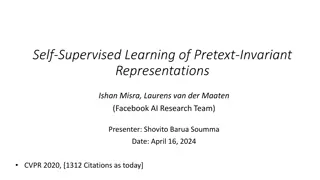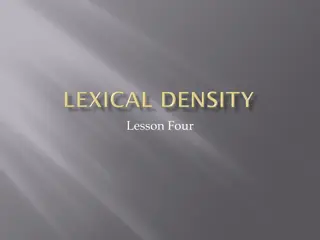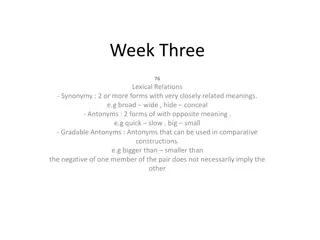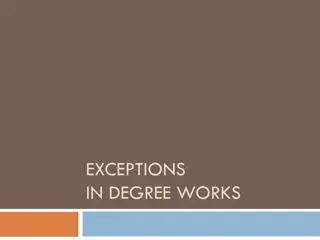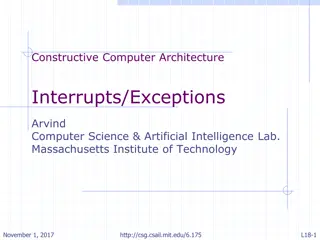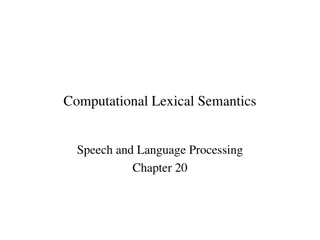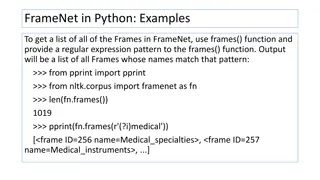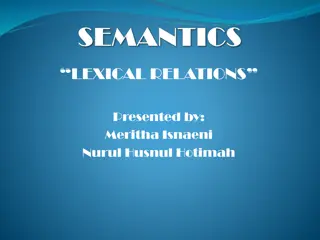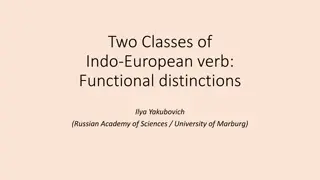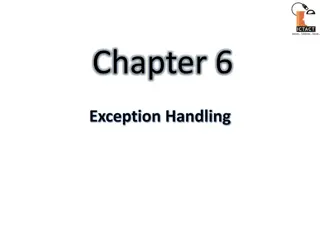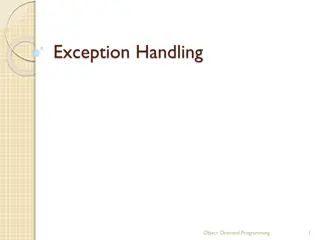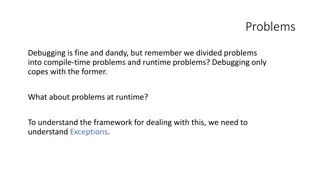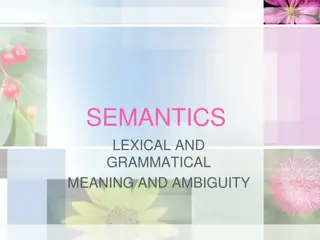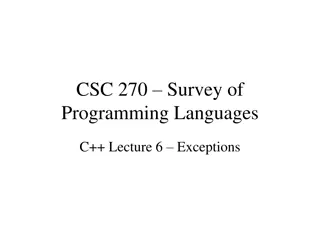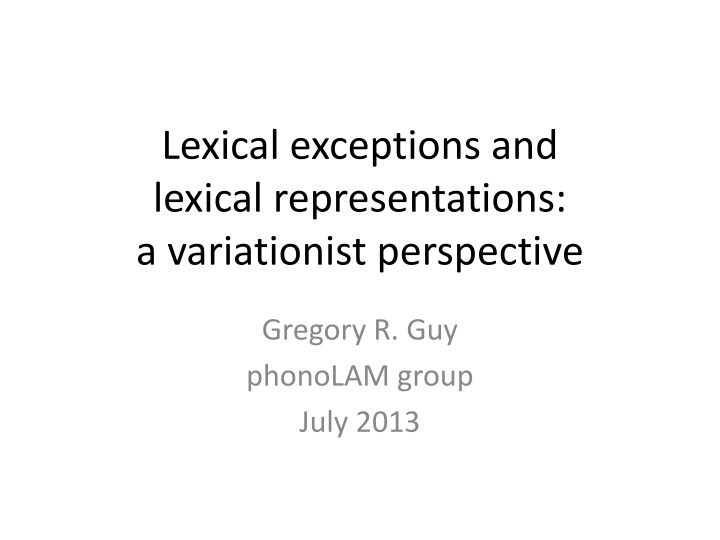
Lexical Exceptions and Representations in Variationist Phonology
Explore the concept of lexical exceptions and representations from a variationist perspective in phonology. Learn about the problem of lexical scope, related issues in phonology, and strategies for handling lexically-restricted patterns. Dive into examples like the English laxing rule and historical borrowings with distinct phonology.
Download Presentation

Please find below an Image/Link to download the presentation.
The content on the website is provided AS IS for your information and personal use only. It may not be sold, licensed, or shared on other websites without obtaining consent from the author. If you encounter any issues during the download, it is possible that the publisher has removed the file from their server.
You are allowed to download the files provided on this website for personal or commercial use, subject to the condition that they are used lawfully. All files are the property of their respective owners.
The content on the website is provided AS IS for your information and personal use only. It may not be sold, licensed, or shared on other websites without obtaining consent from the author.
E N D
Presentation Transcript
Lexical exceptions and lexical representations: a variationist perspective Gregory R. Guy phonoLAM group July 2013
The problem of lexical scope Some phonological generalizations are valid only for a subset of the lexicon in a given language. The subsets are at least partly defined by lexical identity, not phonological shape. Subsets range in size from small to very large.
Example: English laxing rule /i/ alternates with /E/ in many derived words: serene-serenity, obscene-obscenity, scheme- schematic, spleen-splenetic but famously fails to alternate in obese-obesity
Related lexical issues for phonology Lexical exceptions Historical borrowings with distinct phonology (e.g., Latinate vocabulary of English, Chinese- origin vocabulary of Japanese) Recent (unassimilated) borrowings; cf. in English Bach [bax] Proper names
Lexical exceptions Lexical exceptions are lexical items that exceptionally fail to conform to some generalization found in the rest of the lexicon, or show some phonological pattern that (most) other words do not have.
Lexical exceptions and lexical classes Exceptions typically involve just one or a few words. Larger sets of lexical items showing distinct patterns exist in some languages (e.g. Chinese-origin words in Japanese); these are not usually treated as exceptions, but involve the similar issues: how to tie phonological processes to specific words?
Partial lexical scope: The theoretical issue How to associate the statement of the phonological generalization (typically captured by the rule or constraint component of the phonology) with the appropriate lexical set (typically defined in the lexicon)
Two strategies for handling lexically- restricted patterns Word-based: define lexical entries that pre-empt or pre-determine output Phonology-based: constrain processes to apply only to particular lexical subsets
The lexical strategy A lexically-restricted generalization is already encoded in underlying representations, not generated by the phonology Words that fail to show some generalization get URs that block that outcome
The phonological strategy In a rule-based phonology: Exception features: rules are sensitive to features associated with particular lexical items (cf. Chomsky & Halle 1968) Features can trigger or block specific rules Phonological rules are thereby co-indexed with lexical items they apply to
The phonological strategy in OT In a constraint-based approach: Define different constraints for different subsets of the lexicon Co-phonologies: different constraint rankings for different subsets of the lexicon (cf. Inkelas, Ito & Mester, Pater & Coetzee)
Example: Philadelphia // The TRAP vowel (a.k.a. short a , / /) has tense and lax variants in Philadelphia English: / / is tense before tautosyllabic front nasals and fricatives (e.g., ham, man, half, path, pass) but mad, bad, glad are also tense while all other words with following /d/ are not tense (e.g., sad, Dad, had, pad, lad )
Example: Philadelphia // Lexical strategy: list mad, bad, glad with tense / / in the lexicon Phonological strategy: the tensing rule can be triggered by an exception feature, which is listed in the lexical entries for mad, bad, glad
How to choose? In the above example, the two approaches to exceptionality make the same predictions, and are essentially notational equivalents Both strategies are evident in early generative phonology Forty years of research has not decided the issue Both strategies survive the transition to constraint-based phonology
The practice In the absence of a theoretical or empirical proof of the superiority of one or the other, the issue has been left undecided Phonologists pick and choose their strategies according to their preference
And yet The two strategies make quite different claims about mental grammar: The lexical strategy implies that speakers store lots of detail in the lexicon, even if it is redundant and generalizable Phonological strategy implies that speakers always seek to maximize the use of generalizations
An obstacle to resolution: The focus on invariant processes A choice between the two strategies is hampered by the focus on invariant processes: obesity always has /i/, serenity always has /E/ No interaction with context
The limitations of an invariant perspective Categorical processes are abrupt In any given context, a unique outcome is expected Hence, they cannot reflect effects of intersecting constraints (in variationist terminology, all constraints are knockouts )
An alternative approach: look at variable processes Weinreich, Labov and Herzog (1968): Orderly heterogeneity : language variation shows systematic quantitative regularities, probabilistically constrained
The insights from variation Variable processes reflect multiple constraints Every item is affected simultaneously by every contextual feature Hence, quantitative patterns can reveal phonological nuances that don t show up in categorical processes. They may provide solutions to unresolved theoretical problems
Lexical exceptions in variation Many variable processes are known to exhibit unusual frequencies of occurrence in particular lexical items. -e.g., coronal stop deletion in English is exceptionally frequent in and (Exceptional because deletion occurs significantly more often in and than in phonologically comparable words like sand, band, hand, etc.)
Table 1. Exceptional and in the ONZE corpus: N Deletion rate 80% 29% and 597 3348 other words
Some other examples Final /-s/ deletion in Caribbean Spanish: certain discourse markers have exceptionally high rates of s absence. entonce(s) then , digamo(s), let s say . Final /-s/ deletion in Brazilian Portuguese: the first person plural verbal suffix mos shows an exceptionally high rate of s absence. temo(s) we have ; falamo(s) we speak
How to handle lexical exceptions to variable processes? Phonological strategy: exceptional lexical items have a feature that raises or lowers the probability of a given phonological process occurring in that word. Lexical strategy: exceptional words have distinctive lexical entries that affect the surface frequencies of occurrence of variants.
Background: The VR framework The variable rule model of variation treats variable productions as a function of contextual constraint effects (cf. Labov 1968, Cedergren & Sankoff 1973) Each context affecting a phonological process is associated with a probabilistic weight (pi, pj, ) expressing that effect The probability of occurrence of a process in a particular utterance is a logistic function of all relevant contexts
A VR account of English coronal stop deletion The deletion of final stops in cases like west side > wes side, old man> ol man is independently affected by preceding segment: more deletion after obstruents (west) than laterals (old) following segment: more deletion before consonants (wes side) than before vowels (west end) morphology: more deletion in monomorphemic words (mist) than past tense forms (missed)
The frequency of final -t deletion in west side is therefore a function of presence of a preceding /s/, presence of following /s/ morphological status as monomorpheme Each of these effects is independent of all others, and makes a separate contribution to the overall outcome
Phonological strategy for and in the VR model The phonological treatment of lexical exceptions simply assigns a distinct weight to and which is not associated with other lexical items. This weight is high, strongly favoring deletion Tokens of and are still equally affected by all other factors, e.g., following segment
The lexical strategy for and A lexical treatment of the exceptional behavior of and assigns it an alternate entry that pre-encodes the output of the process. and has an alternate lexical entry an or n . When this form is selected, it always surfaces without a final /d/, thereby boosting the apparent rate of coronal stop deletion. (cf. rock n roll, an orthographic representation of this underlying form?)
Testing the strategies: Variation as a window into phonological organization The two strategies for handling lexical exceptions may not be decidable on obligatory/categorical data because of absence of constraint interaction But variation data, showing constraint interaction, allows a test of the models.
The two strategies make different quantitative predictions The phonological strategy using an exception feature simply boosts the overall probability of deletion in and, leaving other constraint effects unchanged. Hence, the effect of following C vs. V should be the same in exceptional and unexceptional words: Cheese n crackers is always deleted more than ham n eggs
The lexical strategy achieves elevated surface rates of -d absence in and by selection of UR an , which does not undergo coronal stop deletion, and is therefore insensitive to constraints on that process. Hence, lexical exceptions show reduced effect of following C vs V: Cheese n crackers is no more likely than ham n eggs
The specific quantitative effect of the lexical strategy: A surface corpus of exceptional words is a mixture of two sets of forms: -some are derived from underlying full forms (e.g. and) and show the effects of constraints on the process, -others are derived from underlying reduced forms (an ) and are not affected by constraints on the process
The mixture of the two sets has the quantitative effect of attenuating the observed effect of constraints on the process. Tokens derived from underlying and, showing an external context effect of a certain magnitude m, are mixed in with tokens derived from an showing zero external context effect. The total set will show an effect intermediate between 0 and m.
Measuring attenuation In a multivariate analysis, this attenuation should be manifested as a smaller range of values in lexical exceptions for a factor group that measures a constraint on the process (e.g., the following segment effect on coronal stop deletion).
Predictions Exception feature: constraint effects should be equivalent in exceptional and nonexceptional corpora Multiple underlying entries: constraint effects should appear to be weaker in exceptional than nonexceptional corpora.
Table 2. Following context effect on English CSD and exceptional and Non-exceptional words N % del Exception (and) N % del __C __V 572 39.3 495 441 312 95.7 82.1 15.8 Range: 23.5% > 13.6% (Source: Neu 1980)
Table 3. Context effects in the ONZE corpus Other words and Following N Context: __C __V % del N % del 1339 1477 58.3 10.4 315 182 87.9 75.3 Range: 47.9% > 12.6% (18 speakers from the ONZE corpus at U Canterbury)
Table 4. Multivariate analysis of following context effect in the ONZE data Following Context: __C[+cor] __C[-cor, +vce] __C[-cor, -vce] __/w/ __V Range: .61 (18 speakers from the ONZE corpus at U Canterbury) Other words Adjusted probabilities of d deletion .83 .90 .76 .72 .29 > .31 and .63 .73 .52 .59 .42
Following context effect appears significantly weaker in exceptional and In both raw deletion percentages and multivariate analyses, in two independent corpora, the effect of following context is much weaker for tokens of and than for other words This is consistent with the lexical strategy: and has an additional UR without a final /d/
Contextual effects on Brazilian Portuguese s deletion Prior research shows this to be strongly constrained by following context Mainly occurs in preconsonantal position Deletion rates are affected by place, manner, and voicing of following C Do these constraints affect exceptional mos words just like other words?
Table 5. Lexical exceptions in Brazilian Portuguese -s deletion Features of following C Non-exceptions Lexical exceptions (-mos forms) .49 .58 .44 .14 Voice/Manner: sonorant voiced obstruent voiceless obstruent Range .69 .44 .36 .33 > Place: labial coronal velar .32 .61 .44 .58 .53 .39 Range .29 > .19 N: Goodness of fit (log likelihood) -704.8 5880 1225 -791.5
Following context effect appears significantly weaker in exceptional -mos Range of probabilities is smaller for both the place effect and the manner/voicing effect The goodness of fit measure is significantly worse for the exceptional forms, suggesting that they aren t as well explained by the contextual conditions Again, this is consistent with a lexical account: the first singular morpheme has an alternate entry mo without final s.
Contextual effects on Salvadoran Spanish s deletion Like other Caribbean Spanish dialects, the Spanish of El Salvador has variable final s deletion Hoffman 2004 finds strong constraint effects on deletion; more deletion in stressed syllables, more deletion before consonants, especially voiced consonants, than before vowels Three discourse markers show exceptionally high rates of deletion: entonces, digamos, pues
Table 6. -s deletion in Salvadoran Spanish (Hoffman 2004) Non-exceptional words Lexical exceptions Following context: sonorant voiced obstruent voiceless obstruent vowel pause (entonces, digamos, pues) .63 .55 .38 .38 .56 > .25 .60 .75 .33 .36 .44 Range .42 Syllable Stress: stressed unstressed .38 .62 .42 .58 Range .24 > .16
Another variable: monophthongal /ay/ in Southern American English (SoAmEng) The English diphthong /ay/ is monophthongized to /a/ in Southern American English This is a variable process, subject to social and contextual constraints More monophthongs are found in pre-voiced contexts (ride vs. right), in phonetically shorter syllables, and among lower status speakers I and my are lexical exceptions, with very high rates of monophthongization, even before voiceless consonants (cf: my time )
Table 7. /ay/ monophthongization in SoAmEng by following context (Woods 2008) Other words 34% I, my 53% % monophthong Fol. Context: __C[+vce] __V or G __C[-vce] Range: .76 .41 .17 (.51) (.49) (.48) .59 > .03 (n.s.)
Table 8. /ay/ monophthongization in Southern AmEng: duration effect Other words I, my Duration: shorter longer .89 .49 .68 .45 Range: .40 (Data from Woods 2008) > .23
Contextual effects are much weaker on exceptional I, my in SoAmEng Following context effect is not significant for I, my Duration effect is much weaker Monophthongization occurs much more often in these two words, and is relatively insensitive to context. This is consistent with alternate URs with monophthongal syllabic nuclei /a:/, /ma:/
Summary: In 7 constraints on 4 processes in 3 languages Magnitude of constraint effect is always weaker for exceptional lexical items than for non-exceptional words This is consistent with predictions of the alternate lexical entry model These results contradict the phonological exception feature model, which predicts that contextual effects should be stable and independent of exceptional status

